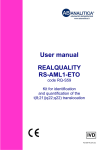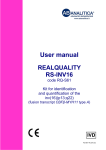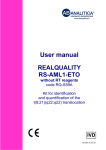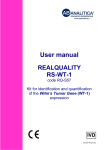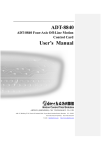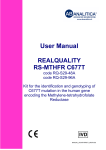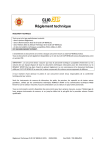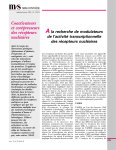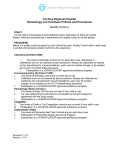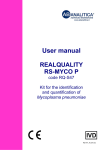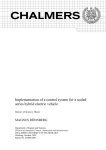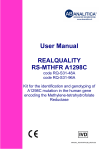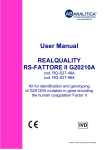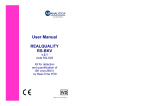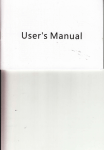Download User manual
Transcript
User manual REALQUALITY RS-PML-RARa bcr3 code RQ-S65 Kit for the identification and quantification of the t(15;17)(q22;q21) translocation bcr3 variant RQ-S65-48_EN.doc 1. 1.1 PRODUCT INFORMATION 3 Intended Use 3 2. KIT CONTENT 4 3. STORAGE AND STABILITY OF THE REAGENTS 5 4. PRECAUTIONS FOR USE 5 5. SAFETY RULES 7 5.1 General safety rules 7 5.2 Safety rules about the kit 7 6. MATERIALS REQUIRED, BUT NOT PROVIDED 8 6.1 Reagents 8 6.2 Instruments 8 6.3 Materials 8 7. INTRODUCTION 9 8. TEST PRINCIPLE 10 9. PRODUCT DESCRIPTION 12 10. COLLECTION, MANIPULATION AND PRE-TREATMENT OF THE SAMPLES 13 11. PROTOCOL 13 11.1 RNA extraction 13 11.2 Retrotranscription (RT) for the synthesis of cDNA 13 11.3 INSTRUMENT PROGRAMMING 11.3.1 Creation of thermal protocol 11.3.2 Plate Setup 15 15 15 11.4 QUALITATIVE ANALYSIS PROTOCOL 15 11.5 QUANTITATIVE ANALYSIS PROTOCOL 17 11.6 ANALYSIS AND INTERPRETATION OF QUALITATIVE RESULTS 18 11.7 ANALYSIS AND INTERPRETATION OF QUANTITATIVE RESULTS 19 1 RQ-S65-48_EN.doc 12. NORMALIZATION AND QUANTIFICATION OF MINIMAL RESIDUAL DISEASE 21 13. TROUBLESHOOTING 22 14. DEVICE LIMITATIONS 24 15. DEVICE PERFORMANCES 24 15.1 Analytical specificity 24 15.2 Analytical sensitivity 24 15.3 Reproducibility 25 15.4 Diagnostic specificity 26 15.5 Diagnostic sensitivity 26 15.6 Accuracy 26 16. REFERENCES 27 17. USEFUL LINKS 27 18. RELATED PRODUCTS 28 RQ-S65-48_EN.doc 2 1. PRODUCT INFORMATION 1.1 Intended Use The REALQUALITY RS- PML-RARa bcr3 is an IVD for the identification and quantification of the t(15;17)(q22;q21) translocation in the bcr3 variant, by amplification of c-DNA in the regions of the genes involved in pml on chromosome 15 and rarα on chromosome 17. The kit allows the absolute quantitative analysis of the PML-RARa bcr3 transcript present in the sample, if used together with the related product REALQUALITY RQ-PML-RARa bcr3 STANDARD (code RQ-66-ST). The technique used in this kit is the Real time PCR amplification, starting from c-DNA obtained by reverse transcription of the RNA extracted from human clinical samples. This is an in vitro diagnostic test that can be used as an auxiliary device for detection and monitoring of the Acute Myeloid Leukaemia (AML), in particular the Acute Promyelocytic Leukemia (APL). The present manual refers to the following product: REALQUALITY RS-PML-RARa bcr3 Kit for the identification and quantification of the t(15;17)(q22;q21) translocation, in the bcr3 variant, by Real time amplification. This product is in accordance with 98/79/CE (Annex III) Directive regarding the in vitro medical diagnostic devices (CE mark). Contains all the reagents needed for the Real time amplification. Code RQ-S65-48 RQ-S65-96 Product PKG REALQUALITY RS-PML-RARa bcr3 48 test REALQUALITY RS-PML-RARa bcr3 96 test 3 RQ-S65-48_EN.doc 2. KIT CONTENT BOX P STORE AT -30°/ -20°C DESCRIPTION TUBE (T) OR LID COLOUR LABEL 24 test 48 test 96 test Reagents for reverse transcription RT MIX 3 x 143 L 6 x 135 L 6 x 260 L Reverse transcription RT enzyme 1 x 17 L 1 x 30 L 2 x 30 L 2X Q Real Time mix 2 x 350 L 3 X 450 L 6 X 450 L Magnesium Chloride solution MgCl2 1 x 50 L 1 X 75 L 1 X 150 L ROX Reference Dye ROX 1 x 30 L 1 X 60 L 2 X 60 L Primer and probe Mix PML-RARa bcr3 Oligomix Green 1 x 27 L 2 x 27 L 4 x 27 L Primer and probe Mix ABL Oligomix Blue 1 x 27 L 2 x 27 L 4 x 27 L Mastermix 2X BAG STORE AT +2°/+8°C DESCRIPTION PML- RARa bcr3 translocation positive control ABL positive control RQ-S65-48_EN.doc LABEL TUBE (T) OR LID COLOUR 24 test 48 test 96 test PML- RARa bcr3 POSITIVE CONTROL Green 1 x 30 L 1 x 60 L 1 x 110 L ABL POSITIVE CONTROL Blue 1 x 30 L 1 x 60 L 1 x 110 L 4 3. STORAGE AND STABILITY OF THE REAGENTS Each component of the kit should be stored according to the directions indicated on the label of the single boxes. In particular: Box P Bag Store at -30°C/-20°C Store at +2°C/+8°C When stored at the recommended temperature, all test reagents are stable until their expiration date. The 2X Q Real Time Mix and Oligomix reagents are sensitive to the physical state variations. The reagents should not go undergo more than two freeze/thaw cycles. If a small number of samples are tested in each batch, it is recommended to aliquot the reagents. Oligomix and ROX contain fluorescent molecules: it is recommended to store these reagents far from any light source. 4. PRECAUTIONS FOR USE The kit must be used only as an IVD and handled by qualified technicians, who are educated and trained in molecular biology techniques applied to diagnostics; Before starting the kit procedure, read carefully and completely the instruction manual; Keep the product away from heating sources and the direct light; Do not use any part of the kit if over the expiration date; In case of any doubt about the storage conditions, box integrity or method application, contact AB ANALITICA technical support at: [email protected]. In the amplification of nucleic acids, the user has to take the following special precautions: Use filter-tips; 5 RQ-S65-48_EN.doc Store the biological samples, the extracted RNA, cDNAs, and positive controls included in the kit and all the amplification products in different places from where amplification reagents are stored; Organize the work space in different pre- and post-PCR units; do not share consumables (pipettes, tips, tubes, etc) between them; Change the gloves frequently; Wash the bench surfaces with 5% sodium hypochlorite; Keep the RNA on ice during reverse transcription assembly. The RNA can be extracted or stored at -30°C/-20°C or at -80°C, according to the time between extraction and reverse transcription. Thaw the reagents prior to use; once thawed, mix the solutions well by inverting the tubes several times (do not vortex!), then centrifuge briefly. RQ-S65-48_EN.doc 6 5. SAFETY RULES 5.1 General safety rules Wear disposable gloves to handle the reagents and the clinical samples and wash the hands at the end of work; Do not pipet by mouth; Since no known diagnostic method can assure the absence of infective agents, it is a good rule to consider every clinical sample as potentially infectious and handle it as such; All the devices that get directly in touch with clinical samples should be considered as contaminated and disposed as such. In case of accidental spilling of the samples, clean up with 10% Sodium Hypochlorite. The materials used to clean up should be disposed in special containers for contaminated products; Clinical samples, materials and contaminated products should be disposed after decontamination by: immersion in a solution of 5% Sodium Hypochlorite (1 volume of 5% Sodium Hypochlorite solution every 10 volumes of contaminated fluid) for 30 minutes; OR autoclaving at 121°C at least for 2 hours (NOTE: do not autoclave solutions containing Sodium Hypochlorite!!) 5.2 Safety rules about the kit The risks for the use of this kit are related to the single components. Dangerous components: none. The Material Safety Data Sheet (MSDS) of the device is available upon request. 7 RQ-S65-48_EN.doc 6. MATERIALS REQUIRED, BUT NOT PROVIDED 6.1 Reagents Reagents for density gradient separation of mononucleate cells (Ficoll); RNA extraction reagents; Dnase- and Rnase-free sterile water; Distilled water; REALQUALITY RQ-PML-RARa bcr3 STANDARD code RQ-66-ST (for quantitative analysis). 6.2 Instruments Laminar flow cabinet (its use is recommended for preparing the amplification mix to avoid contamination; it is recommended to use another laminar flow cabinet to add the extracted DNA and standards); Micropipettes (range: 0.5-10 µL; 2-20 µL; 10-100 µL; 20-200 µL; 1001000 µL); Microcentrifuge (max 12-14,000 rpm); Plate centrifuge (optional); Thermocycler (for reverse transcription); Real time amplification instrument. The product was validated on Applied Biosystems 7500 Fast DX, 7300, and StepOnePlus Real-Time PCR system (Applied Biosystems); the product is compatible with instruments that can use 25 μL of reaction volume and that can detect the FAM fluorescence correctly. For more information regarding the compatibility of the kit with other commercial instruments, please contact AB ANALITICA’s technical assistance. 6.3 Materials Talc-free disposable gloves; Disposable sterile filter-tips (range: 0.5-10 µL; 2-20 µL; 10-100 µL; 20200 µL; 100-1000 µL); Sterile DNase and RNase free tubes (for reverse transcription); 96-well plates for Real Time PCR and the adhesive optical film or 0.1-0.2 mL tubes with optical caps. RQ-S65-48_EN.doc 8 7. INTRODUCTION Due to the easy access to malignant cells in the blood of leukemia and lymphoma patients. Research on those types of cancer has opened the way to understand the cellular and molecular mechanisms underlying also many other neoplastic diseases where cell samples are much harder to obtain or require invasive procedures (e.g. solid tumors). Acute Promyelocytic Leukemia (APL) is a subtype of Acute Myeloid Leukemia (AML) with a M3 cytomorphology that constitutes 10 – 15% of all AML cases, In more than 90% of patients the APL is associated with the t(15;17)(q22;q21) translocation (also called t(15;17)(q24;q21)). This translocation results in a fusion of the PML gene (promyelocytic leukemia gene), located in region 22 (or 24 depending on nomenclature) of the long arm of chromosome 15, and the RARα gene (retinoic acid receptor α) in region 21 of the long arm of chromosome 17. The breaking point of the RARα gene is inside a region of 15 Kb of intron 2. The breaking point of the PML gene can be found in three different regions: intron 6 (55% of cases), intron 3 (40% of cases) and exon 6 (5% of the cases). Each breaking point is associated with a particular isoform of the PML-RARα fusion protein, called bcr 1, bcr 3 and bcr 2, respectively. This fusion protein is a transcriptional repressor that blocks the differentiation of hematopoietic stem cells which then remain in the promyelocyte stage. Treatment with ATRA (All Trans Retinoic Acid) as a differentiation driving factor is a very effective therapy for APL. The translocation can be detected at the molecular level using a method that involves extraction of total RNA of the starting sample, reverse transcription of the RNA into cDNA and specific amplification and quantification of the fused region(s). Detection and analysis of the translocation not only delivers valuable information for diagnosis and prognosis of these types of leukemia, but above all provides the means to monitor the Minimal Residual Disease (MRD). Minimal Residual Disease (MRD) denotes the survival of a number of neoplastic cells in the body of a cancer/leukemia patient during chemotherapy and/or a symptomless remission phase. Those cells usually cannot be detected using standard cytomorphologic techniques. Although aggressive chemotherapy has considerably advanced leukemia treatment, a significant percentage of patients experience a relapse in various stages after the treatment. Usually, this is the result of the presence of therapy-resistant residual cells. The characteristics of these cells have remained unknown for a long time due to the limited sensitivity of techniques available. Lately, the 9 RQ-S65-48_EN.doc Silinmiş: THanksThe …study of …of …pathologies ... [1] Silinmiş: . Those, thanks to the availability and samples Silinmiş: of leukemic malignant cells in the blood, unlike the solid tumors ones that are sometimes difficult to collect without using invasive samplings. ¶ ¶ La traslocazione t(15;17)(q22;q21) è frequentemente associata (più del 90% dei casi) alla Leucemia Acuta Promielocitica (APL), un sottotipo di Leucemia Mieloide Acuta (AML) con citomorfologia M3. Le APL costituiscono il 10-15% dei casi di AML.¶ The t(15;17)(q22;q21) comes …from the …between the pml ... [2] Biçimlendirilmiş: Yazı tipi: İtalik Silinmiş: situated …on q22…rarα ... [3] Biçimlendirilmiş: Yazı tipi: İtalik Silinmiş: situated on q21…rarα ... [4] Biçimlendirilmiş: Yazı tipi: İtalik Silinmiş: located …the …; ... t[5] Biçimlendirilmiş: Yazı tipi: İtalik Silinmiş: pml…, instead,…happen …possible isoform…respectively … …,… ... [6] Silinmiş: e derived …the ,…blocked …, working as a differentiation driving factor ... [7] Silinmiş: detection can be done…with a…RT-PCR which consists of a …its retro transcription … and the following …of the regions ... of [8] Silinmiş: This detection gives useful …first of all allows … with consequent repercussion on therapy. ... [9] Silinmiş: MRD describes…the that remain…, which … …with the …cases …at …different /time…A disease relapse …the persist…ence…of a number of , whose …sensibility analysis ... [10] Biçimlendirilmiş: Yazı tipi: (Varsayılan) Arial, 14 nk, Kalın Değil PCR has provided new possibilities for a more extended and efficient MRD monitoring (van Dongen et al., 1998; Baccarani et al., 2006). Silinmiş: The Silinmiş: opened Silinmiş: application on MMR In the light of what has been said before molecular analysis of the t(15;17)(q22;q21) translocation appears very important for diagnosis and monitoring of APL patients. Not only detection but also quantification of the PML-RARα transcript proved to be an important tool. It has been shown that the amount of PML-RARα transcript during the recovery phase is a strong risk indicator for a hematologic relapse. Also, levels of PML-RARα transcript remaining high during remission-maintenance therapy and the end of chemotherapy were associated with a high risk of clinical relapse and a negative prognosis (Santamaria et al., Haematologica 2007).. Silinmiş: Therefore, The Silinmiş: is Silinmiş: the Silinmiş: the Silinmiş: In particular, the positivity of Silinmiş: Silinmiş: is associated with different levels of risk for reoccurrence. During the recovery phase, Silinmiş: positivity 8. TEST PRINCIPLE Silinmiş: is PCR method (Polymerase Chain Reaction) was the first method of DNA amplification described in literature (Saiki RK et al., 1985). It can be defined as an in vitro amplification reaction of a specific part of DNA (target sequence) by a thermostable DNA polymerase. This technique was shown to be a valid and versatile molecular biology instrument: its’ application contributed to a more efficient study of new genes and their expression and it brought to a revolution in the laboratory diagnostic and forensic medicine field. The REAL TIME PCR technology represents an advancement of the basic PCR technique; it allows to measure the number of DNA molecules amplified during the exponential amplification phase. The amplicon monitoring is essentially based on the labeling of the primers and probes, or of the amplicons themselves, with fluorescent molecules. In the first case, the Fluorescence Resonance Energy Transfer (FRET) among the two fluorophores, or other mechanisms which lead to fluorescence emission and involve a fluorophore and a non-fluorescent quencher (molecular beacon, scorpion primer, etc) are used. The mechanism that determines the fluorescence emission is based on the presence of a quencher molecule, located in proximity of a reporter molecule, that blocks the fluorescence emission by the reporter. When the quencher is separated from the reporter, the latter emits fluorescence. The real time detection of such fluorescence is accomplished by means of a thermalcycler equipped with fluorescence detector. Each amplification cycle will release a certain amount of fluorescence into the solution; the cycle at which the amplification generates the minimal amount of fluorescence needed to overcome the basal noise threshold is called the “cycle threshold” (Ct). By intuition, the higher the starting concentration of the target nucleic RQ-S65-48_EN.doc 10 Açıklama [AM1]: a following hematological relapse Açıklama [AM2]: ???? Silinmiş: predictive indicator for successive homological reoccurrences; during the maintaining therapy until the end of the chemotherapy treatment, the positivity of PML-RARα is associated Silinmiş: reoccurrence acid, the sooner the amplification will reach the cycle threshold. The Ct value is reached during the exponential phase of the amplification reaction, where the amplification reaction is still proportional to the number of target molecules in the solution. The starting concentration of the unknown samples is determined by comparison of the Ct value of each sample with the Ct value of a standard curve acquired at known concentration (Figure 1). Figure 1: Creation of a standard curve starting from the standard Ct values at known concentration. Main advantages of the Real time PCR technique, compared to the conventional amplification techniques, are for example the possibility to execute a semi-automated analysis in which the time needed for the visualization of the amplicons is eliminated; and the absence of the postamplification sample manipulation that reduces the possible contamination phenomena. 11 RQ-S65-48_EN.doc 9. PRODUCT DESCRIPTION REALQUALITY RS-PML-RARa bcr3 kit code RQ-S65 allows the identification of t(15;17)(q22;q21) translocation, in the bcr3 variant. If used with the REALQUALITY RQ-PML- RARa bcr3 STANDARD (code RQ66-ST) product, the kit allows the absolute quantification of the number of PML-RARa bcr3 transcripts in the sample, normalized compared to the number of ABL housekeeping gene transcripts. Such quantification is obtained by making a standard curve with 4 points for PML- RARa bcr3 and, in parallel, a standard curve with 4 points for ABL. Starting from the same c-DNA but in a separate PCR reaction, the sequence of housekeeping gene ABL is amplified. In addition to being a reference for the quantification and normalization, it also allows to evaluate both the quality of the extracted RNA and the following retro-transcription reaction, and the possible presence of PCR reaction inhibitors. This valid tool helps the user to recognize possible false negative results. The amplification of ABL gene is made separately from the one for PMLRARa, because experimental evidence demonstrates that a competition between the two targets can occur in samples with a low number of PMLRARa transcripts, and sometimes it heavily disadvantages the amplificationof the specific translocation, with the possibility to have false negative. The given positive controls are made by a DNA fragment with the target region of interest, and they are not dangerous for the user. A ready-to-use mastermix is provided with all the reagents needed (except for the oligomix). The dUTP/UNG system in the mix allows to prevent contaminations from previous amplification, being able to remove uracil residues in the single or double stranded DNA molecules. NOTE: This kit was developed in accordance with the Europe Against Cancer guidelines (Gabert et al., Leukemia 2003) and in accordance with recent international recommendations (Branford et al., Leukemia 2006). RQ-S65-48_EN.doc 12 10. COLLECTION, MANIPULATION AND PRETREATMENT OF THE SAMPLES The search of the PML-RARa bcr3 translocation is performed starting from whole peripheral or bone marrow blood. Sample collection should follow all the usual sterility precautions. Blood must be treated with EDTA. Other anticoagulation agents, as heparin, are strong inhibitors of TAQ polymerase and so they could alter the efficiency of the RT-PCR reaction. Fresh blood can be stored at +2°C/+8°C if processed in 4h time after the collection: the mononucleate cells must be separated by density gradient centrifugation (Ficoll – reagent not included in the kit). The RNA can be extracted immediately from the pellet containing the lymphocytes; otherwise, the cell pellet may be conserved at -80°C until the RNA extraction, better if preserved in a buffer containing RNAse inhibitors (ex.: RLT buffer - QIAGEN or Trizol). 11. PROTOCOL 11.1 RNA extraction The product was validated using the RNeasy Mini kit (QIAGEN). However, it is possible to use any extraction method, provided that it allows the isolation of pure and integral RNA. Please follow the instructions below regarding the quantity of RNA to be used for the reverse transcription reaction (about 1µg). 11.2 Retrotranscription (RT) for the synthesis of cDNA Attention: before starting the reverse transcription procedures, it is recommended to use an ice container and to thaw one or more RT-mix aliquotes (depending on the number of analyzed samples). Once thawed, the RT-mix must be mixed well by inverting the tube a number of times (do not vortex!), then centrifuged briefly and stored on ice until use. 13 RQ-S65-48_EN.doc For each sample, use a sterile DNase and RNase free tube, and add (see paragraph 6.3): Extracted RNA 5 μL* *NOTE: The 5 μL amount indicates the void volume available for the reaction. The appropriate amount of RNA to be used for reverse transcription is about 1 μg; if the RNA is more concentrated, it is necessary to dilute it properly with DEPC H2O. Insert the tubes in the thermalcycler and program the following thermal profile: 1 cycle 70°C, 10 min Next, put the tubes on ice immediately, for at least 5 minutes. Add 14.5 μL of RT-mix and 0.5 μL of RT Enzyme, mix by pipetting, centrifuge briefly and incubate in a thermalcycler programmed as below: 1 cycle 20°C, 10 min 42°C, 45 min 99°C, 3 min 4°C, 5 min Once the cycle ends, add 30 μL of sterile water to each retrotranscribed sample. The diluted cDNA can be stored in a fridge for short period of time (maximum one week), or at -20° C/-30°C for long periods of time. N.B.: this cDNA can be used both for the amplification of the PML-RARa bcr3 translocation and ABL housekeeping gene. Further, the same cDNA can be used also be used for the test of the PML-RARa bcr1 translocation (by using the correlated product REALQUALITY RS- PML-RARa bcr1 code RQ-S63). RQ-S65-48_EN.doc 14 11.3 INSTRUMENT PROGRAMMING 11.3.1 Creation of thermal protocol Set the following thermal profile: Cycle Repeats Step Time (°C) 1 2 1 1 1 1 2:00 10:00 50.0 95.0 3 45 1 00:15 95.0 2* 01:00 60.0 UNG Activation Taq Activation Amplification cycles * Fluorescence collection step 11.3.2 Plate Setup Mark the negative control (NTC), standard (STD) and sample (Unknown) position on the grid corresponding to the new plate, in the same position as loaded on the plate and identify each sample with a name. NOTE: It is recommended to amplify both the samples and positive controls/standards in duplicates. For the quantitative protocol, define the dilutions of the PML-RARa bcr3 standards and the ABL standards in a range from 105 copies to 102 copies. Select and activate the FAM fluorophore, and set the quencher to NONE. Pay attention that the ROX fluorescence detection is activated in each position, if required by the instrument used. Set the reaction volume to 25 μL if and when needed. 11.4 QUALITATIVE ANALYSIS PROTOCOL Once thawed, mix the reagents by inverting the tubes several times (do not vortex), then centrifuge briefly. Prepare the reaction mix rapidly at room temperature or work on ice or on a cooling block. Take care to work shaded from the direct light as much as possible. Prepare a master mix of an appropriate volume, that must be sufficient for all the samples to be processed, for the positive controls and the negative control in which the H2O is added instead of DNA (when calculating the 15 RQ-S65-48_EN.doc volume, consider an excess of at least one reaction volume), as indicated below. It is recommended to amplify both the samples and positive controls/standards in duplicates. ROX™ is an inert dye whose fluorescence does not change during the amplification reaction; on instruments that allow its use (Applied Biosystems, Stratagene, etc) it allows to normalize the well-to-well differences due to artifacts such as pipetting errors or instrument limits. In case in which different instruments are used, do not add ROX to the reaction mix and adjust the reaction volume appropriately with sterile water. PML-RARa bcr3 ROX NON ROX Amplification Instruments Instruments Reagent 1 Reaction 1 Reaction 2X Q Real Time Mix 12.5 μL 12.5 μL Oligo Mix PML-RARa bcr3 1 μL 1 μL MgCl2 0.5 μL 0.5 μL ROX 0.5 μL -H2O 5.5 μL 6 μL Total Volume 20 μL 20 μL ABL Amplification Reagent 2X Q Real Time Mix Oligo Mix ABL MgCl2 ROX H2O Total Volume ROX NON ROX Instruments Instruments 1 Reaction 1 Reaction 12.5 μL 12.5 μL 1 μL 1 μL 0.5 μL 0.5 μL 0.5 μL -5.5 μL 6 μL 20 μL 20 μL Mix by inverting the tube in which the mix was prepared several times. Then centrifuge briefly. Pipet 20 μL of the mix on the bottom of each well on the plate. Add 5 μL of cDNA to each well, or 5 μL of positive control DNAs included in the kit, in the correct positions on the plate. RQ-S65-48_EN.doc 16 Always amplify a negative control together with the samples to be analyzed (add sterile water to the amplification mix instead of cDNA) both for the PMLRARa bcr3 and the ABL mix. Hermetically seal the plate by using the optic adhesive film and the appropriate sealer. Make sure there are no air bubbles in the bottom of the wells and/or centrifuge the plate at 4000 rpm for about 1 minute. Load the plate on the instrument making sure to position it correctly and start the amplification cycle. 11.5 QUANTITATIVE ANALYSIS PROTOCOL The quantitative analysis can be performed by using the related product REALQUALITY RQ-PML-RARa bcr3 STANDARD code RQ-66-ST. It is recommended to amplify both the samples and the standards in duplicates. Follow the instructions reported in the previous paragraph to prepare a reaction mix sufficient for the standard curve acquisition and quantification of tested samples both for the PML- RARa bcr3 and the ABL gene. A negative amplification control must be included on the plate, in which the H2O is added instead of cDNA. Aliquot 20 μL of the mix on the bottom of each well on the plate. Add 5 μL of cDNA to each well, or 5 μL of each quantification standard dilution in the corresponding positions on the plate. Hermetically seal the plate by using the optic adhesive film and the appropriate sealer. Make sure there are no air bubbles in the bottom of the wells and/or centrifuge the plate at 4000 rpm for about 1 minute. Load the plate on the instrument making sure to position it correctly and start the amplification cycle. 17 RQ-S65-48_EN.doc 11.6 ANALYSIS AND INTERPRETATION OF QUALITATIVE RESULTS Check the reaction graph when the reaction has ended. Analyze PML-RARa bcr3 and ABL graphs and amplification results separately. And follow the interpretation pattern as indicated. Before analyzing the samples results check the expected positive and negative controls results. ABL Positive Control ABL Negative Control PML-RARa bcr3 Positive Control PML-RARa bcr3 Negative Control RQ-S65-48_EN.doc RESULT INTERPRETATION Amplification signal Correct ABL amplification No amplification signal Amplification problems, repeat the analysis No amplification signal No contamination Amplification signal Contamination, repeat the analysis RESULT INTERPRETATION Amplification signal Correct PML-RARA amplification No amplification signal Amplification problems, repeat the analysis No amplification signal No contamination Amplification signal Contamination, repeat the analysis 18 BCR3 Sample: ABL amplification Sample: PML-RARa bcr3 amplification RESULT Amplification signal INTERPRETATION Sample suitable for amplification No amplification signal Sample not suitable for amplification: RNA degradation; reverse transcription error (repeat the RT: if again no amplification occurs, repeat the RNA extraction) Amplification signal PML-RARA BCR3 positive sample translocation No amplification signal PML-RARA BCR3 negative sample translocation NOTE: When analyzing duplicates, one positive well is sufficient to detect a positive sample; while both the wells must be negative to diagnose a negative sample for translocation. For ABL values, samples with ABL Ct corresponding to the copy n° that is < than the minimum limit of the linearity range (see paragraph 15 “Device performances”) must be excluded from the analysis The International scientific community also defined an ABL Ct range within which the samples can be considered adequate for the analysis (ABL Ct 21.8 - 29.4, J Gabert et al. Leukemia 2003). This is of particular importance when studying the Minimal Residual Disease in samples with a low PML-RARa bcr3 1 copy number: it allows the obtained result to be sure and it excludes the possibility that a low copy number of PML-RARa bcr3 is due to the low cell number in the starting sample. 11.7 ANALYSIS AND INTERPRETATION OF QUANTITATIVE RESULTS Check the reaction graph when the reaction has ended. Analyze the PML-RARa bcr3 and ABL graphs and quantification results separately. View in the logarithmic scale (Fig. 2) and position the threshold in order to obtain a correlation coefficient (R2) and slope of the standard curve closest to the following respective values 1 and -3.33 (Fig. 3). The results are acceptable with a amplification efficiency within the 85-110% range (slope about -3.75 - -3.10) and a correlation coefficient not less than 0.990. 19 RQ-S65-48_EN.doc Fig. 2: Post run data analysis: PML-RARa bcr3 amplification graph in logarithmic scale viewed on su Applied Biosystems StepOnePlus Real time PCR System con software version 2.1. Fig. 3: Post run Analysis of the data: standard curve viewed on su Applied Biosystems StepOnePlus Real time PCR System con software version 2.1. RQ-S65-48_EN.doc 20 12. NORMALIZATION AND QUANTIFICATION OF MINIMAL RESIDUAL DISEASE The PML-RARa bcr3 and ABL standard curves allow to transform the Ct values obtained for unknown samples in PML- RARa bcr3 (PML- RARa bcr3 CN) and ABL (ABLCN) copy numbers. The normalized copy number (NCN) of the PML- RARa bcr3 transcript is defined as the ratio between the PML- RARa bcr3 CN and ABLCN copy number: NCNPML- RARa bcr3 = PML- RARa bcr3 CN/ ABLCN The Minimal Residual Disease (MRD) is expressed as the ratio between the PML-RARa bcr3 normalized copy number at the follow-up (FUP) and the PML-RARa bcr3 normalized copy number at the time of the diagnosis (DX): MRD = (PML-RARa bcr3 CN/ ABLCN)FUP/ (PML-RARa bcr3 CN/ ABLCN)DX In case of the follow-up samples, the sensitivity (SENSv) of the experiment must be calculated in order to determine the clinical validity of the obtained results: SENSv = ABLCN,DX/ (ABLCN,FUP x PML-RARa bcr3,DX) 21 RQ-S65-48_EN.doc 13. TROUBLESHOOTING Absence of positive control/standard and sample amplification signal The instrument was not programmed correctly – Repeat the amplification taking care of the instrument programming; pay particular attention to the thermal profile, the selected fluorophores and the correspondence between the plate protocol and the plate itself. The amplification mix was not prepared correctly – Prepare a new amplification mix making sure to follow the instructions given in the paragraph 11.4 The kit was not stored properly or it was used beyond the expiry date – Check both the storage conditions and the expiry date reported on the label; use a new kit if needed Delay in positive controls/standard amplification signals Positive controls/standards were stored inappropriately and have decayed – Make sure to store the positive controls/standards appropriately at +2°/+8°C, and that these reagents do not undergo any freeze/thaw cycle as well; – Do not use the positive controls/standards beyond the expiry date. The reaction mix does not function correctly – Make sure to store the 2X Q Real Time mix and oligomix appropriately at -20°C/-30°C. Avoid unnecessary freeze/thaw cycles. Delayed or no ABL amplification signal in the samples The extracted RNA is not suitable for amplification or a problem may have occurred during the reverse transcription reaction and the amplification reaction is inhibited – Make sure to perform the extraction of nucleic acids correctly – If an extraction system uses Ethanol wash steps, make sure no ethanol residual remains in the DNA sample – Use the extraction systems suggested in paragraph 10.1 – during the reverse transcription reaction, check visually the deposition of the Reverse Transcriptase enzyme in the tube, by RQ-S65-48_EN.doc 22 observing the drop formed by the enzyme on the tube wall after its addition to the mix; then centrifuge briefly. – Follow the standard procedures for minimization of the RNA degradation: use the RNase free plastic lab ware and work on ice during the reverse transcription reaction. For any further problems contact AB ANALITICA’s technical support at: [email protected], fax (+39) 049-8709510, or tel. (+39) 049-761698). 23 RQ-S65-48_EN.doc 14. DEVICE LIMITATIONS The kit can have reduced performances if: The clinical sample is not suitable for this analysis (i.e. heparin-treated blood or use of other unsuitable anticoagulants) The treatment of the starting sample was not performed as indicated in the paragraph 10 The kit was not stored correctly. 15. DEVICE PERFORMANCES 15.1 Analytical specificity The analytical specificity of the REALQUALITY RS-PML-RARa bcr3 kit, code RQ-S65, is guaranteed by an accurate and specific selection of primers and probe, and also by the use of the stringent amplification conditions. The alignment of primers and probes in the most important databanks shows the absence of non-specific pairing. 15.2 Analytical sensitivity Detection limit: The analytical sensitivity limit of REALQUALITY RS-PMLRARa bcr3 kit was defined by the amplification test of 8 dilution replicates from the last point of the quantification standard conducted in at least 3 consecutive runs. The results are reported in Table 1. Linear range: It was calculated using a dilution panel of the quantification standard. The analysis of the data obtained with a linear regression demonstrated that the dose present for the RS-PML-RARa bcr3 and ABL give linear responses to all the points in the panel (R2>0.99). The results are reported in Table 1. RQ-S65-48_EN.doc 24 15.3 Reproducibility In order to determine the inter-assay variability (variability of the replicates of the same sample in the same run), a 50 copy transcript/μL of the quantification standard (corresponding to a final quantity of 250 transcript copies/reaction) was amplified in 8 replicates in the same run. The intra-assay coefficient variability of the method, referring to the threshold cycle (Ct), for RS-PML-RARa bcr3and ABL is reported in Table 1. In order to calculate the inter-assay variability (variability of the replicates of the sample in different runs), the results obtained from the amplification of the last point of the quantification standard (20 transcript copies/μL corresponding to 100 transcript copies/reaction) conducted in duplicates in at least 3 consecutive runs is considered adequate. For each run, the variable coefficient was calculated from the Ct of the samples. The inter-assay variable coefficient for RS-PML-RARa bcr3 and ABL, was calculated from the average of the variable coefficients in each experiment performed, as reported in Table 1. ABI 7500 Fast Dx Table 1 Detection Limit (copies/rxn) PML-RARa bcr3 Linear Range (copies/rxn) ABL Intra-assay Variability Inter-assay Variability ABI 7300 StepOne Plus 5 5 5 (100% positivity) (95.8% positivity) (100% positivity) 10 – 105 PML-RARa bcr3 5 - 106 ABL 0.508% 0.633% 0.345% PML-RARa bcr3 0.453% 0.799% 0.633% ABL 0.916% 0.669% 0.454% PML-RARa bcr3 1.001% 0.740% 0.608% 25 RQ-S65-48_EN.doc 15.4 Diagnostic specificity A significant number of samples negative for PML-RARa bcr3 translocation was tested simultaneously with the REALQUALITY RS-PML-RARa bcr3 kit and another CE IVD or reference method. The obtained results indicate that the diagnostic specificity of this device is 100%. 15.5 Diagnostic sensitivity A significant number of positive samples for the PML-RARa bcr3 translocation were tested simultaneously with the REALQUALITY RS-PMLRARa bcr3 kit and another CE IVD or reference Real Time method. The obtained results were positive for all of the tested samples, allowing to calculate a diagnostic sensitivity of 100%. 15.6 Accuracy This value was calculated by the number of correct amplifications over the total number of executed amplifications. The REALQUALITY RS-PML- RARa bcr3 device has an accuracy of 100%. RQ-S65-48_EN.doc 26 16. REFERENCES Baccarani M, Saglio G, Goldman J et al. Blood 15;108(6):1809-20, 2006 Bloomfield CD, Lawrence D, Byrd JC et al. Cancer Res 58; 4173-4179, 1998 Branford S, Cross NC, Hochhaus A et al. Lukemia 20(11):1925-30, 2006 Gabert J, Beillard E, et al. Leukemia 17(12):2318-57, 2003 Saiki RK, S Scharf, F Faloona, KB Mullis, GT Horn, HA Erlich and N Arnheim, Science 230, 1350-1354, 1985. Van der Velden VH et al. Leukemia 17, 1013-1034, 2003 van Dongen JJ et al. Lancet 352, 1731-1738, 1998. 17. USEFUL LINKS www.hematology.org www.bloodjournal.org www.bloodline.net www.haematologica.it www.il-st-acad-sci.org/data6.html http://medocs.ucdavis.edu/IMD/420A/dib/index.htm http://web.tiscali.it/ematologia www.ematologia-italia.net/frame_b.htm 27 RQ-S65-48_EN.doc 18. RELATED PRODUCTS REALQUALITY RQ-PML-RARa bcr3 STANDARD: Quantified and ready-to-use quantification standard for the transcript of the t(15;17)(q22;q21) translocation, in the bcr3 variant. Code Product PKG RQ-66-ST REALQUALITY 4 x 60 µL PML-RARa bcr3 RQ-PML-RARa bcr3 STANDARD 4 x 60 µL ABL REALQUALITY RS-PML-RARa bcr1: Kit for the identification and quantification of the t(15;17)(q22;q21) translocation, in the bcr1 variant, by Real Time PCR. Code RQ-S63 RQ-S65-48_EN.doc Product PKG REALQUALITY RS-PML-RARa 48/96 test bcr1 28 AB ANALITICA srl Via Svizzera 16 - 35127 PADOVA, (ITALY) Tel +39 049 761698 - Fax +39 049 8709510 e-mail: [email protected] Sayfa 9: [1] Silinmiş Andrej Mantei 07.12.2011 17:42:00 Andrej Mantei 07.12.2011 17:44:00 Andrej Mantei 09.12.2011 10:17:00 Andrej Mantei 09.12.2011 10:16:00 Andrej Mantei 09.12.2011 10:18:00 THanksThe Sayfa 9: [1] Silinmiş study of Sayfa 9: [1] Silinmiş of Sayfa 9: [1] Silinmiş pathologies Sayfa 9: [2] Silinmiş of leukemic malignant cells in the blood, unlike the solid tumors ones that are sometimes difficult to collect without using invasive samplings. La traslocazione t(15;17)(q22;q21) è frequentemente associata (più del 90% dei casi) alla Leucemia Acuta Promielocitica (APL), un sottotipo di Leucemia Mieloide Acuta (AML) con citomorfologia M3. Le APL costituiscono il 10-15% dei casi di AML. The t(15;17)(q22;q21) Sayfa 9: [2] Silinmiş Andrej Mantei 09.12.2011 10:28:00 Andrej Mantei 09.12.2011 10:28:00 Andrej Mantei 09.12.2011 10:29:00 Andrej Mantei 09.12.2011 10:29:00 Andrej Mantei 09.12.2011 10:35:00 Andrej Mantei 09.12.2011 10:35:00 Andrej Mantei 09.12.2011 10:31:00 Andrej Mantei 09.12.2011 10:35:00 Andrej Mantei 09.12.2011 10:36:00 Andrej Mantei 09.12.2011 10:44:00 Andrej Mantei 09.12.2011 10:45:00 Andrej Mantei 09.12.2011 10:45:00 Andrej Mantei 09.12.2011 10:45:00 comes Sayfa 9: [2] Silinmiş from the Sayfa 9: [2] Silinmiş between the pml Sayfa 9: [3] Silinmiş situated Sayfa 9: [3] Silinmiş on Sayfa 9: [3] Silinmiş q22 Sayfa 9: [3] Silinmiş rarα Sayfa 9: [4] Silinmiş situated on Sayfa 9: [4] Silinmiş q21 Sayfa 9: [4] Silinmiş rarα Sayfa 9: [5] Silinmiş located Sayfa 9: [5] Silinmiş the Sayfa 9: [5] Silinmiş ;t Sayfa 9: [6] Silinmiş Andrej Mantei 09.12.2011 10:45:00 Andrej Mantei 09.12.2011 10:46:00 Andrej Mantei 09.12.2011 10:46:00 Andrej Mantei 09.12.2011 10:46:00 Andrej Mantei 09.12.2011 10:47:00 Andrej Mantei 09.12.2011 10:47:00 Sayfa 9: [6] Silinmiş Andrej Mantei 09.12.2011 10:47:00 Sayfa 9: [6] Silinmiş Andrej Mantei 09.12.2011 10:47:00 Sayfa 9: [6] Silinmiş Andrej Mantei 09.12.2011 10:47:00 Sayfa 9: [7] Silinmiş Andrej Mantei 09.12.2011 10:48:00 Andrej Mantei 09.12.2011 10:48:00 Sayfa 9: [7] Silinmiş Andrej Mantei 09.12.2011 10:48:00 Sayfa 9: [7] Silinmiş Andrej Mantei 09.12.2011 10:49:00 Andrej Mantei 09.12.2011 10:49:00 pml Sayfa 9: [6] Silinmiş , instead, Sayfa 9: [6] Silinmiş happen Sayfa 9: [6] Silinmiş possible Sayfa 9: [6] Silinmiş isoform Sayfa 9: [6] Silinmiş respectively , e derived Sayfa 9: [7] Silinmiş the , blocked Sayfa 9: [7] Silinmiş , working as a differentiation driving factor Sayfa 9: [8] Silinmiş Andrej Mantei 09.12.2011 10:50:00 Andrej Mantei 09.12.2011 10:50:00 Andrej Mantei 09.12.2011 10:51:00 Andrej Mantei 09.12.2011 10:51:00 Andrej Mantei 09.12.2011 10:51:00 Andrej Mantei 09.12.2011 10:53:00 Andrej Mantei 09.12.2011 10:55:00 detection can be done Sayfa 9: [8] Silinmiş with a Sayfa 9: [8] Silinmiş RT-PCR which consists of a Sayfa 9: [8] Silinmiş its retro transcription Sayfa 9: [8] Silinmiş and the following Sayfa 9: [8] Silinmiş of the regions of interest Sayfa 9: [9] Silinmiş This detection gives useful Sayfa 9: [9] Silinmiş Andrej Mantei 09.12.2011 10:55:00 Andrej Mantei 09.12.2011 10:58:00 first of all allows Sayfa 9: [9] Silinmiş with consequent repercussion on therapy. Sayfa 9: [10] Silinmiş Andrej Mantei 09.12.2011 10:58:00 Andrej Mantei 09.12.2011 11:00:00 Andrej Mantei 09.12.2011 11:00:00 Andrej Mantei 09.12.2011 11:03:00 Sayfa 9: [10] Silinmiş Andrej Mantei 09.12.2011 11:03:00 Sayfa 9: [10] Silinmiş Andrej Mantei 09.12.2011 11:03:00 Andrej Mantei 09.12.2011 11:03:00 Andrej Mantei 09.12.2011 11:05:00 Andrej Mantei 09.12.2011 11:06:00 Andrej Mantei 09.12.2011 11:05:00 Andrej Mantei 09.12.2011 11:06:00 Andrej Mantei 09.12.2011 11:06:00 Andrej Mantei 09.12.2011 11:06:00 Andrej Mantei 09.12.2011 11:06:00 Andrej Mantei 09.12.2011 11:06:00 Andrej Mantei 09.12.2011 11:07:00 Andrej Mantei 09.12.2011 11:08:00 Andrej Mantei 09.12.2011 11:08:00 MRD describes Sayfa 9: [10] Silinmiş the Sayfa 9: [10] Silinmiş that remain Sayfa 9: [10] Silinmiş , which with Sayfa 9: [10] Silinmiş the Sayfa 9: [10] Silinmiş cases Sayfa 9: [10] Silinmiş at Sayfa 9: [10] Silinmiş different Sayfa 9: [10] Silinmiş /time Sayfa 9: [10] Silinmiş A disease relapse Sayfa 9: [10] Silinmiş the persist Sayfa 9: [10] Silinmiş ence Sayfa 9: [10] Silinmiş of a number of Sayfa 9: [10] Silinmiş , whose Sayfa 9: [10] Silinmiş sensibility Sayfa 9: [10] Silinmiş analysis



































